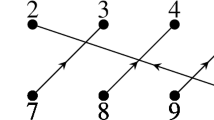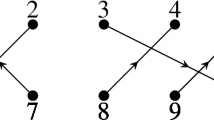Abstract
Suppose Γ is a group acting on a set X, written as (Γ,X). An r-labeling f: X→{1,2, ..., r} of X is called distinguishing for (Γ,X) if for all σ∈Γ,σ≠1, there exists an element x∈X such that f(x)≠f(x σ). The distinguishing number d(Γ,X) of (Γ,X) is the minimum r for which there is a distinguishing r-labeling for (Γ,X). If Γ is the automorphism group of a graph G, then d(Γ,V (G)) is denoted by d(G), and is called the distinguishing number of the graph G. The distinguishing set of Γ-actions is defined to be D*(Γ)={d(Γ,X): Γ acts on X}, and the distinguishing set of Γ-graphs is defined to be D(Γ)={d(G): Aut(G)≅Γ}. This paper determines the distinguishing set of Γ-actions and the distinguishing set of Γ-graphs for almost simple groups Γ.
Similar content being viewed by others
References
M. O. Albertson and K. L. Collins: Symmetry breaking in graphs, Electron. J. Combin. 3 (1996) #R18, 17.
M. O. Albertson and D. L. Boutin: Using determining sets to distinguish Kneser graphs, Electron. J. Combin. 14 (2007), no. 1, #R20, 9.
P. Cameron, P. M. Neumann and J. Saxl: On groups with no regular orbits on the set of subsets, Arch. Math. 43 (1984), 295–296.
G. H. Chan: A characterization of minimal (k)-groups of degree n≤3k, Linear and Multilinear Algebra 4 (1976/77), No. 4, 285–305.
K. L. Collins: private communication, 2006.
J. H. Conway, R. T. Curtis, S. P. Norton, R. A. Parker, R. A. Wilson: Atlas of Finite Groups, Clarendon Press, Oxford, 1985.
S. Dolfi: Orbits of permutation groups on the power set, Arch. Math. 75 (2000), 321–327.
The GAP Group: GAP — Groups, Algorithms and Programming, Version 4.4.12, 2008. (http://www.gap-system.org)
D. Gluck: Trivial set-stabilizers in finite permutation groups, Can. J. Math. XXXV (1983), No. 1, 59–67.
S. Jiang: Distinguishing labeling of S 5-actions, Master Thesis, National Sun Yat-sen University, 2006.
S. Klavžar, T. Wong and X. Zhu: Distinguishing labelings of group action on vector spaces and graphs, Journal of Algebra 303 (2006), 626–641.
M. W. Liebeck: Graphs whose full automorphism group is a symmetric group, J. Austral. Math. Soc. Ser. A 44 (1988), 46–63.
D. Marusic: On vertex symmetric digraphs, Discrete Mathematics, 36 (1981), 69–81.
D. Marusic and R. Scapellato: Classifying vertex-transitive graphs whose order is a product of two primes, Combinatorica 14(2)(1994), 187–201.
D. W. Miller: On a theorem of Hölder, Amer. Math. Monthly 65 (1958), 252–254.
Yoav Segev: The commuting graph and minimal nonsolvable groups, Geometriae Dedicata 88 (2001), 55–66.
A. Seress: Primitive groups with no regular orbits on the set of subsets, Bull. London Math. Soc. 29 (1997), 697–704.
A. Seress: The minimal base size of primitive solvable permutation groups, J. London Math. Soc. 53 (1996), No. 2, 243–255.
M. Suzuki: Group theory. I. Grundlehren der Mathematischen Wissenschaften [Fundamental Principles of Mathematical Sciences], 247. Springer-Verlag, Berlin-New York, 1982.
J. Tymoczko: Distinguishing numbers for graphs and groups, Electron. J. Combin. 11 (2004), #R63, 13.
D. West: Open Problems #23, http://www.math.uiuc.edu/west/pcol/pcolink.html
M. Yossi: On permutation groups and partitions, Comm. Algebra 30 (2002), No. 10, 4889–4903.
H. Wielandt: Finite permutation groups, Academic Press, New York, 1964.
Author information
Authors and Affiliations
Additional information
Supported in part by the NSF and by ARC Grant DP1096525
Supported in part by the National Science Council under grant NSC92-2115-M-110-010
Supported in part by ZJNSF under grant Z6110786.
Rights and permissions
About this article
Cite this article
Seress, Á., Wong, TL. & Zhu, X. Distinguishing labeling of the actions of almost simple groups. Combinatorica 31, 489–506 (2011). https://doi.org/10.1007/s00493-011-2221-7
Received:
Revised:
Published:
Issue Date:
DOI: https://doi.org/10.1007/s00493-011-2221-7




